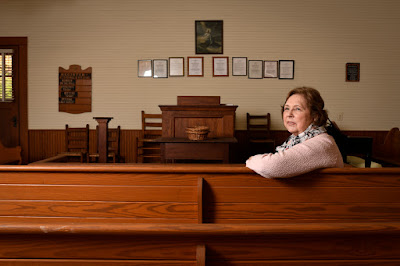 |
(A slightly different version of this post originally appeared on the Sigma lens site. You can see it here.)
I shoot a lot of portraits. My work for magazines, annual reports, advertising and personal projects has relied on portraiture for years. I use prime lenses for most of these, but for certain kinds of projects, zooms might work best. This article tells about one such situation.
I shoot a lot of portraits. My work for magazines, annual reports, advertising and personal projects has relied on portraiture for years. I use prime lenses for most of these, but for certain kinds of projects, zooms might work best. This article tells about one such situation.
In the spring of 2014 I was talking to an acquaintance and
our respective weekend plans came up. She mentioned that her husband was going
out of town to compete in a rodeo. She was African American so, at the risk of
seeming nosy, I asked if her husband was black, too. She said, yes, and my surprise
and curiosity led to a long conversation where she told me that there was a
whole series of rodeos catering to primarily or exclusively black cowboys.
That night I started doing research on black rodeos and
cowboys. I discovered that the history of African American cowboys and their
role in settling the West isn’t that much different from the history of other
African American groups- it’s been largely ignored by historians and the media.
Estimates are that African Americans made up as much as 25% of the cowboys responsible
for the movement West.
There are, however, people working to battle this ignorance.
A number of groups around the country celebrate the heritage of the black men
and women who herded cattle, farmed, and built homesteads across the West. With
rodeos, trail riding associations, and community outreach groups, contemporary
African Americans work to keep these traditions alive and make the public aware
of this history. The photographs in Black
Cowboys (and girls) are intended to support these efforts and allow the
faces of the participants to be shown with the respect and dignity they
deserve.
 |
Tyshun Cook is a forklift operator from Lakeshore,
AL and is shown outside the arena before the Southeast Rodeo Association event
in Birmingham, Alabama on June 25, 2016. Shot with Nikon D600 and Sigma 24-35mm
F2 DG HSM | Art at 35mm. Lit with Elinchrom ELB and Quadra Hybrid. Exposure
1/160 at F8, ISO 100.
 |
Tailgating before the rodeo is an important part of the
atmosphere. Some of the attendees
come prepared like Curtis Parham, shown outside the arena before the Southeast
Rodeo Association event in Birmingham, Alabama on June 25, 2016. Shot with
Nikon D600 and Sigma 24-35mm F2 DG HSM | Art at 35mm. Lit with Elinchrom ELB and
Quadra Hybrid. Exposure 1/60 at F8, ISO 100.
As I said earlier, most often, I use primes when I shoot
portraits. I plan to write about that process soon, but for Black Cowboys (and girls) my lighting
scheme is somewhat different than what I usually use. I’m shooting with a Elinchrom ELB battery strobe with a beauty dish off camera, but with issues
of bright sunlight, hats with large brims, and dark skin, finding a solution
for a fill light was critical to seeing my subjects’ eyes. I decided to use a
ring light on camera. I was able to turn the power down significantly, thereby
opening up the deep shadows just a bit, without ruining the effect of my main
light.
 |
 |
Behind the scenes showing set up of above photograph.
My problem was that if I shot with primes, I found that when I wanted to change my composition, I had to either take the time to change lenses- a slow and tedious process with a ring light- or, if I moved closer or farther away, I had to take the time to take an additional light meter reading, since changing the distance from the camera and ring light to my subject changed my exposure, not to mention the effect of the fill light.
When shooting environmental portraits, I find myself most
often using either a 24mm or a 35mm prime lens on my full frame Nikons.
Occasionally I’ll go as wide as 20mm or as tight as 50mm, but my 24 and 35 get
the most use. With the Sigma 24-35 F2 Art, I get the best of both without the hassle of
changing lenses or having to adjust exposure. I can stay in one spot and zoom
in and out as needed to reframe my subject and show more or less of the scene.
The fast F2 maximum aperture is a help when I’m shooting in the low light of
arenas.
These last two images show exactly what it looks like as I
zoom in from 24mm to 35mm. It clearly changes the feeling of the image to a more
intimate look and, even with the ring flash, I didn’t have to change the
exposure. It allowed me to work quickly and efficiently with Willie and his
horse without spooking the animal anymore than I already had with my flashes.
 |








































